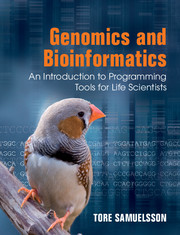Book contents
- Frontmatter
- Contents
- Preface
- Acknowledgements
- Design and conventions of this book
- 1 Introduction: working with the molecules of life in the computer
- 2 Gene technology: cutting DNA
- 3 Gene technology: knocking genes down
- 4 Gene technology: amplifying DNA
- 5 Human disease: when DNA sequences are toxic
- 6 Human disease: iron imbalance and the iron responsive element
- 7 Human disease: cancer as a result of aberrant proteins
- 8 Evolution: what makes us human?
- 9 Evolution: resolving a criminal case
- 10 Evolution: the sad case of the Tasmanian tiger
- 11 A function to every gene: termites, metagenomics and learning about the function of a sequence
- 12 A function to every gene: royal blood and order in the sequence universe
- 13 A function to every gene: a slimy molecule
- 14 Information resources: learning about flu viruses
- 15 Finding genes: going ashore at CpG islands
- 16 Finding genes: in the world of snurpsp
- 17 Finding genes: hunting for the distant RNA relatives
- 18 Personal genomes: the differences between you and me
- 19 Personal genomes: what’s in my genome?
- 20 Personal genomes: details of family genetics
- Appendix I Brief Unix reference
- Appendix II A selection of biological sequence analysis software
- Appendix III A short Perl reference
- Appendix IV A brief introduction to R
- Index
- References
8 - Evolution: what makes us human?
Published online by Cambridge University Press: 05 August 2012
- Frontmatter
- Contents
- Preface
- Acknowledgements
- Design and conventions of this book
- 1 Introduction: working with the molecules of life in the computer
- 2 Gene technology: cutting DNA
- 3 Gene technology: knocking genes down
- 4 Gene technology: amplifying DNA
- 5 Human disease: when DNA sequences are toxic
- 6 Human disease: iron imbalance and the iron responsive element
- 7 Human disease: cancer as a result of aberrant proteins
- 8 Evolution: what makes us human?
- 9 Evolution: resolving a criminal case
- 10 Evolution: the sad case of the Tasmanian tiger
- 11 A function to every gene: termites, metagenomics and learning about the function of a sequence
- 12 A function to every gene: royal blood and order in the sequence universe
- 13 A function to every gene: a slimy molecule
- 14 Information resources: learning about flu viruses
- 15 Finding genes: going ashore at CpG islands
- 16 Finding genes: in the world of snurpsp
- 17 Finding genes: hunting for the distant RNA relatives
- 18 Personal genomes: the differences between you and me
- 19 Personal genomes: what’s in my genome?
- 20 Personal genomes: details of family genetics
- Appendix I Brief Unix reference
- Appendix II A selection of biological sequence analysis software
- Appendix III A short Perl reference
- Appendix IV A brief introduction to R
- Index
- References
Summary
The concept of evolution is of fundamental importance in genomics and bioinformatics, as already emphasized in Chapter 1. Over the next three chapters we will be looking at questions related to the evolution of species, as well as the evolution of individual genes and proteins. First, we will specifically address the question of how humans are genetically different to other animals, such as our close relative the chimpanzee. At the level of bioinformatics and computational tools we will introduce multiple sequence alignment s and show how to analyse such alignments with programming tools.
Genetic differences between humans and chimpanzees
Now that the complete genome sequences of humans and many other animals are known, we are in a position to address interesting questions about similarities and differences between animals in terms of genetic information. Humans clearly have functions that other animals seem to be lacking, such as advanced spoken and written languages and abstract-level thinking. Many cultural activities such as music and painting also seem to be specific to humans. We are definitely distinct from other animals in these respects, even when considering our close primate relatives. With the genome sequences now available, there is an obvious question to answer: what are the significant genetic differences between us and other primates such as the chimpanzee? It would be particularly interesting to identify the genetic elements that are likely to affect brain function. First of all, it should be kept in mind that the identity between the human and chimpanzee genomes is quite extensive. Thus, if we consider the portions of the human and chimpanzee genomes that may be aligned to each other, there are approximately 35 million single nucleotide differences (Chimpanzee Sequencing and Analysis Consortium, 2005). This is to say that in this respect the genomes are in fact 99% identical. In addition, there are about five million insertion/deletion events, accounting for another 3% difference between humans and chimpanzees.
Information
- Type
- Chapter
- Information
- Genomics and BioinformaticsAn Introduction to Programming Tools for Life Scientists, pp. 92 - 104Publisher: Cambridge University PressPrint publication year: 2012
